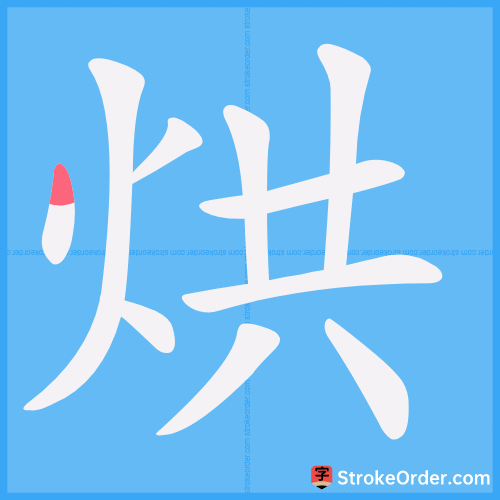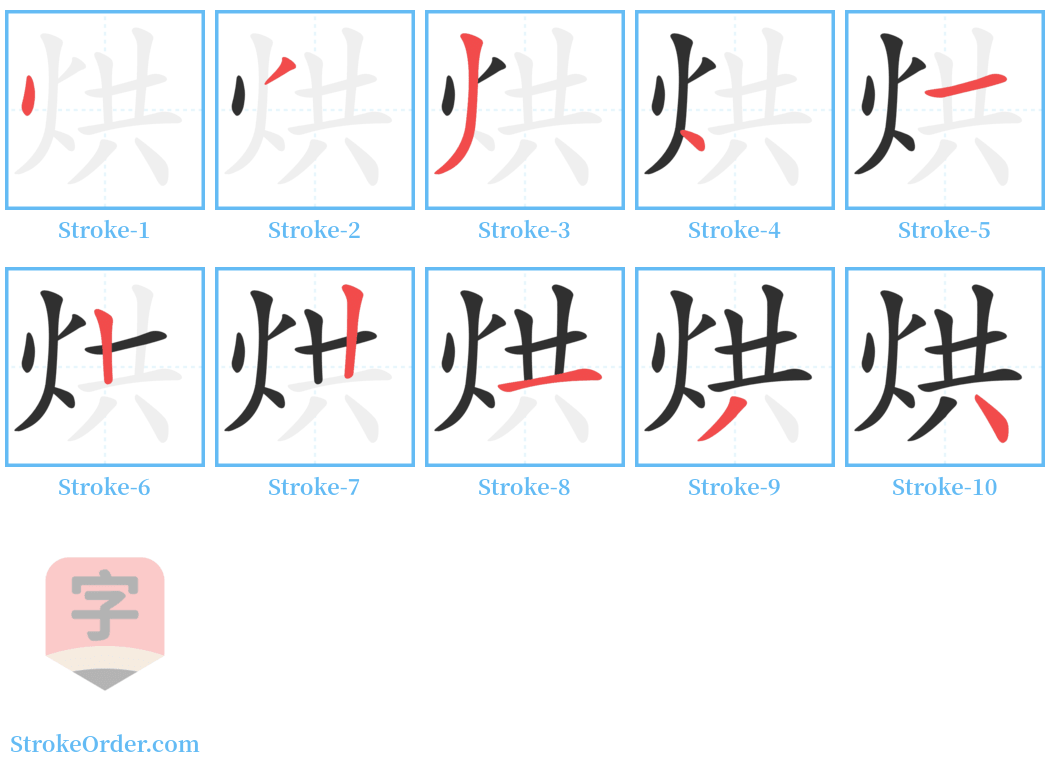烘 Stroke Order
Animated Stroke Order of 烘

Stroke Order Diagrams for 烘

Step-by-Step Handwriting Guide for 烘

Learn to Write Chinese Characters with Video Tutorials
Watch the video of writing the Chinese character "烘", learn the correct stroke order (笔顺) of the character "烘", and master the standard way of writing the character "烘".
Free Printable Handwriting Practice with Stroke Order: 烘
Printable Writing Practice Worksheet of "烘" in Portrait Orientation (Tian Zi Ge)

Printable Writing Practice Worksheet of "烘" in Landscape Orientation (Tian Zi Ge)

Information of 烘
Pinyin
hōng
Radical
火
Strokes
10 strokes
Usage
★★★★★
Definition
bake / heat by fire
烘 (hōng)
1. 用火或蒸气使身体暖和或使物体变热、干燥:如烘箱、烘手、烘干、烘烤。(To warm the body or heat and dry objects using fire or steam: for example, warming box, warming hands, drying, roasting.)
2. 烧。(To burn.)
3. 衬托,渲染:如烘衬、烘托、烘染,烘云托月(喻从侧面加以点染以烘托所描绘的事物)。(To set off by contrast: such as highlighting, contrast highlighting, and embellishing; comparing to the idiom 'to set off the moon by clouds'—used metaphorically to describe subtly enhancing the main subject.)
4. 映照。(To shine upon.)
5. 用同“哄”。人同时发出声音。(To make a sound simultaneously as in 'roar'.)
Examples:
- 烘眼 (hóng yǎn) refers to eye diseases like keratitis, commonly known as "red-eye".
- 烘焰 (hōng yàn) refers to a bright flame.
- 烘腾腾 (hōng téng téng) describes a vigorous flame.
2. 烤干;烤热。(To dry by fire; to roast.)
Examples:
- 烘火 (hōng huǒ) refers to warming oneself by the fire.
- 烘咖啡豆 (hōng kā fēi dòu) means to roast coffee beans.
- 烘衣服 (hōng yī fú) refers to drying clothes.
- 烘鸡 (hōng jī) means to roast chicken.
3. 衬托;渲染。(To set off by contrast.)
Example:
- 烘晕 (hōng yūn) means to highlight.
4. 映照。(To shine upon.)
Examples:
- 烘明 (hōng míng) means bright and clear.
- 烘霁 (hōng jì) means the light shining after the rain.
- 烘晴 (hōng qíng) means sunlight shining upon clear skies.
- 烘影 (hōng yǐng) means casting reflections.
5. 用同“哄”。人同时发出声音。(To roar; simultaneous sound by a group.)
Example:
- 烘堂 (hōng táng) refers to a place where many people laugh simultaneously.
- 烘然 (hōng rán) describes a noisy situation.
background (of a painting) / backdrop / a foil (to set off something to advantage) / to offset (something to advantage)
lit. to shade in the clouds to offset the moon (idiom); fig. a foil / a contrasting character to a main hero
Input Method for 烘
Pinyin
hong1
Wubi
oawy
Cangjie
ftc
Zhengma
uoeo
Four Corner
94881
Unicode
U+70d8
Same Pronunciation Characters